Having built a beautiful and highly functional WordPress website may seem like a mission accomplished but it is only the beginning.
Taking care of your website by keeping up with regular WordPress maintenance tasks will help keep it up and running, secure and serving your users.
It’s an ongoing process that rewards the effort you put in with reliability and stability and is something every website owner needs to get to grips with.
You can choose to hire a WordPress maintenance service, or you can do this yourself.
It doesn’t take long and isn’t that involved. Even better, anyone, at any WordPress experience level can effectively maintain a website!
This page covers everything you need to know about WordPress maintenance. We hope it helps!
- The Benefits of WordPress Maintenance
- How to Put Your Website in Maintenance Mode
- WordPress Website Maintenance Checklist
- WordPress Maintenance Tasks for Security
- WordPress Maintenance Tasks for Performance
- WordPress Maintenance Tasks for SEO
- 6 Best WordPress maintenance and support services
- Get Started With Your WordPress Website Maintenance
The Benefits of WordPress Maintenance
Regular maintenance is good practice. This is particularly true in the world of WordPress, as it’s made up of multiple elements that all have to work perfectly in concert.
Due to the open source nature of the WordPress core, updates and developments are relatively frequent.
Missing an update or two might mean that your website becomes prone to theme and plugin conflicts, not to mention, dangerously exposed in terms of security.
Here are three reasons why you should devote some time to regular WordPress maintenance:
Maintain WordPress for a Better Performance
Every WordPress website has a database that stores all the content associated with it. Over time, the database tends to accumulate lots of data but not all of it is useful.
Regular database optimization and maintenance will help to trim unnecessary data, keeping your database in top shape.
Maintaining Your WordPress Website Means Enhanced Security
According to WPScan, there are 22,805 known WordPress vulnerabilities affecting the WordPress core, plugins, and themes. Now, this is not as dire as it sounds.
When a vulnerability is discovered in a theme, plugin or in the WordPress core, these are typically fixed in updates.
To keep your website safe, take advantage of those updates!
In addition to regular updates, there are a few WordPress security best practices to follow. We’ll get into these shortly!
Proactive Search Engine Optimization
Thanks to Google’s Core Web Vitals, websites that are fundamentally sound can expect more traffic. In addition to this, you’re going to want to keep up or stay ahead of your competition by producing the most relevant content in your field.
This means periodically performing a content gap analysis, and figuring out ways to improve your existing content to best meet the needs of your readers.
How to Put Your Website in Maintenance Mode
Now that you know why you should keep up with WordPress maintenance, it’s time to discover how.
Your first question might be, “do I need to use the WordPress maintenance mode when conducting WordPress website maintenance?” The short answer is, it depends.
Putting your website into maintenance mode is not necessary for routine maintenance tasks. For troubleshooting, any serious issues that concern the core of your website, using maintenance mode is definitely a good idea.
There are five different ways to put a WordPress website in maintenance mode. For this guide we’ll take a look at two. These are using a plugin or adding a bit of code manually.
Use a Plugin
Using a plugin is straightforward and easy and there are several plugins you can use.
Here are a few to try:
- Coming Soon Page, Maintenance Mode & Landing Pages by SeedProd
- Coming Soon and Maintenance Mode by Wpdevart
- Maintenance by WebFactory Ltd
Manually Add Some Code
In addition to using a plugin, you can also activate WordPress maintenance mode manually by pasting a bit of code into the functions.php file.
To get there, log into WordPress and navigate to Appearance > Theme Editor > functions.php.
Once there, paste in the following code at the bottom of the page:
function wp_maintenance_mode() {
if (!current_user_can('edit_themes') || !is_user_logged_in()) {
wp_die('<h1>Under Maintenance</h1><br />Website under planned maintenance. Please check back later.');
}
}
add_action('get_header', 'wp_maintenance_mode');Then save the change.

Naturally, once you are done with your maintenance work, you will want to exit maintenance mode. You can do this simply by removing this piece of code and clicking Update File.
Now you’re in maintenance mode, you’re ready to get to work!
WordPress Website Maintenance Checklist
We’ve divided this guide up to cover the different functional areas such as security, performance, and SEO.
Before you get into all this, step one is backing up your website!
- Back up your files
- WordPress maintenance tasks for security (2-tasks)
- WordPress maintenance tasks for performance (6-tasks)
- WordPress Maintenance Tasks for SEO (4-Tasks)
1. Backup Your Files
Having a backup of your WordPress files is the most fundamental maintenance task. With up-to-date backups, no matter what happens, your website will always be just a few clicks away from coming back to life.
Fortunately, creating a backup is very easy to do using a plugin like UpdraftPlus, which we recommend. To get started with this plugin, download it from the WordPress repository and install it on your website.
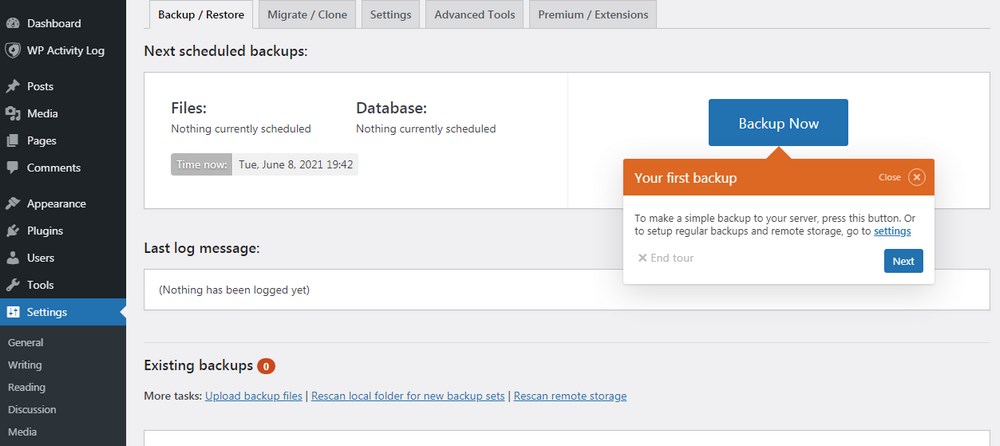
Once installed, click through to Settings and enter in details such as back up frequency, remote storage options (such as Google drive or email), and so on.
Once done, save the changes and navigate to the Backup/Restore tab. Click Backup Now and that will be it.
WordPress Maintenance Tasks for Security
The open source nature of WordPress makes it easy for attackers to find vulnerabilities. That makes security a top priority for every website owner.
With good security practices you will be able to keep your website protected from most threats.
2. Change Passwords
Hopefully, you use strong passwords on all your websites and other online accounts. This is the first step to protecting your website from external threats.
You should also avoid the trap of using one password for every one of your online activities. While remembering passwords can be hard, this is not the optimal solution.
Instead, you may consider using a password tool such as LastPass.
3. Review Security Logs
In addition to changing your passwords and regularly backing up your website, you should also habitually create and check your WordPress activity/security log.
The average WordPress user may not have the technical knowledge to instinctively recognize when their website is under attack. The good news is that frequent reviews of your WordPress activity and security logs will quickly bring any unauthorized or questionable activities to your attention.
This is particularly important because once hackers have gained access to your website, other security measures such as changing passwords or regularly backing up your website might be futile.
You can create activity logs using a plugin like WP Activity Log.
To begin, download and install the plugin from the WordPress repository. Upon installation, you will be prompted to initiate the configuration wizard.
Click Yes and follow the steps.
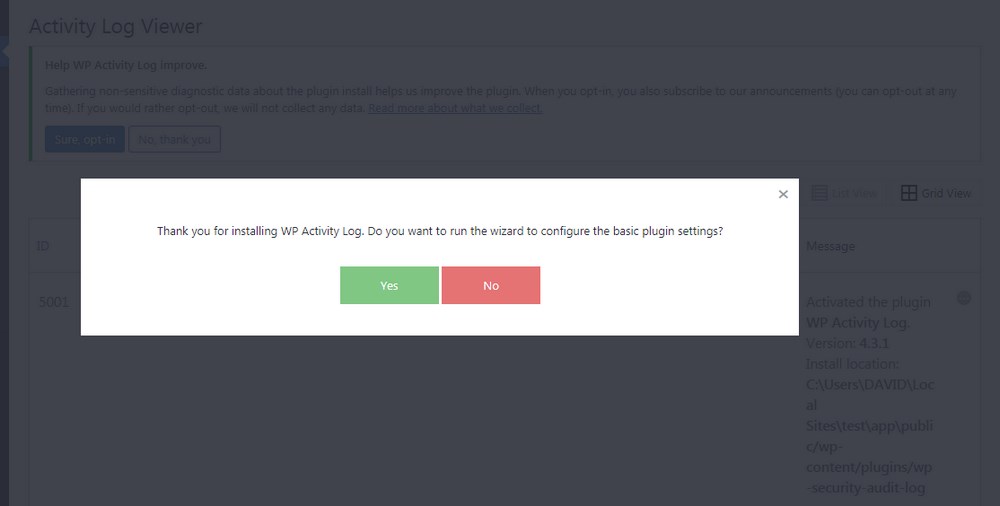
You can also use a WordPress security plugin such as WordFence or Sucuri to provide extra layers of security to your WordPress website.
These plugins will help provide firewalls, change your login URL, minimize login attempts, blacklist malicious IP addresses, and so on.
WordPress Maintenance Tasks for Performance
Making sure that your website loads fast, and functions properly in every area should be a priority. Little things that may go unnoticed such as broken links or non functional forms can easily put readers off.
Without regular maintenance, you may not even notice when this happens! Here are the performance-related maintenance tasks to keep an eye on regularly:
4. Test for Browser and Device Compatibility
Browser and device compatibility are things most WordPress users may take for granted but you shouldn’t.
If you have carried out any major changes to the appearance of your website, such as trying a new theme, you should check to see that all your website’s HTML, CSS, and Javascript is compatible with major browsers such as Chrome, Firefox, Safari, and Edge.
To check for browser compatibility, use a simple tool like powermapper.com.
Additionally, you should check that your website design is perfectly responsive. This means its appearance automatically gets adjusted to provide the best user-experience for different devices such as mobile or tablet.
You can use Chrome DevTools Device Mode to check for device compatibility. If you use a fully responsive theme like Astra, you won’t have to worry too much about this.
5. Test Your Forms
Forms are an essential component of good web-design. Most people use a plugin to integrate highly-functional forms into their WordPress websites, and in general, if you use a high-quality forms plugin such as WPForms, you will have little to worry about.
Still, you should periodically check to see that every single form on your website is working properly.
Problems with forms are not always due to issues with a forms plugin itself. They could also be down to issues with your hosting configuration, your email service provider, and so on.
With this many pieces to the puzzle, there is a lot that could go wrong so keeping an eye on your plugins is a good idea.
Testing forms is a straightforward process. All you have to do is log out of your website and attempt to use each form on your website. If anything isn’t working for you, it likely won’t be working for your users.
6. Update WordPress Core, Plugins and Themes
The WordPress core, themes and plugins will receive updates which may fix various issues such as security weaknesses. Regularly updating all WordPress files once updates become available is a smart idea.
The WordPress core, plugins and themes can all be set to automatically update. However, automatic updates might mean that you do not have enough time to evaluate how everything might work together.
The best practice is to update all files in a staging environment first. Once you have some idea how updates will play out on your live website, you can go ahead and implement them on your live site.
WordPress will attempt to inform you of pending updates but you should always check the updates page to see what you may have missed.
To get there, access your WordPress Dashboard then navigate to Updates.
Once there, you will see what parts of your WordPress installation require an update.
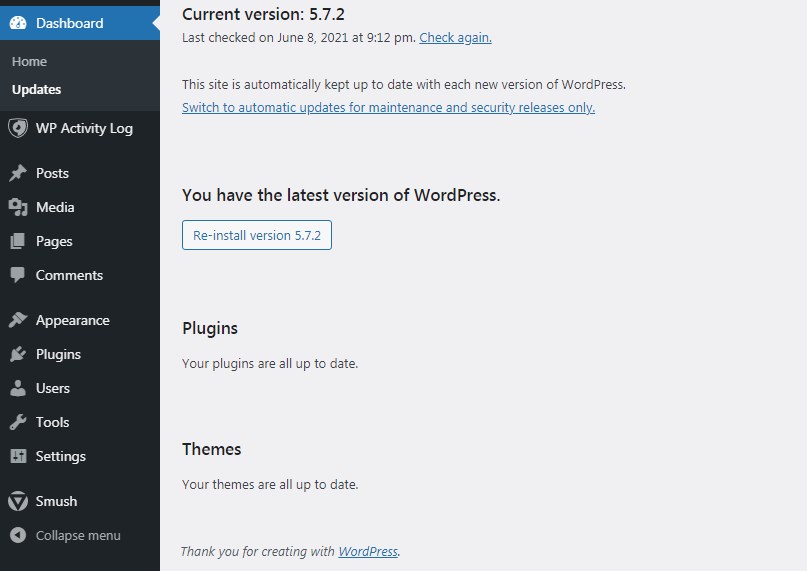
7. Optimize the Database
Every WordPress installation has an associated database. This database contains all the content from your website, including posts and pages, comments, users, settings and so on.
While the database exists for the purpose of collecting data, some data is unnecessary. Keeping too much of it will only slow down your WordPress website and make it inefficient.
Periodic database maintenance will help to keep your WordPress database performing optimally.
While you can optimize your database manually, the simpler solution is to use an optimization plugin such as WP-Optimize.

To begin, simply install the plugin and activate it. By default, it comes with pre-configured settings so all you have to do is click “Run all selected optimizations”.
To get there, navigate to WP-Optimize in your Dashboard > Database.
8. Catch and Fix Broken Links
Broken links are URLs linking to content that no longer exists. When a user clicks on a broken link, they will be shown a 404 page. This is quite negative for user experience, and should be avoided as much as possible.
It is usually very easy to check your website for any broken links. Simply use a broken link checking plugin such as Broken Link Checker by WPMU Dev.
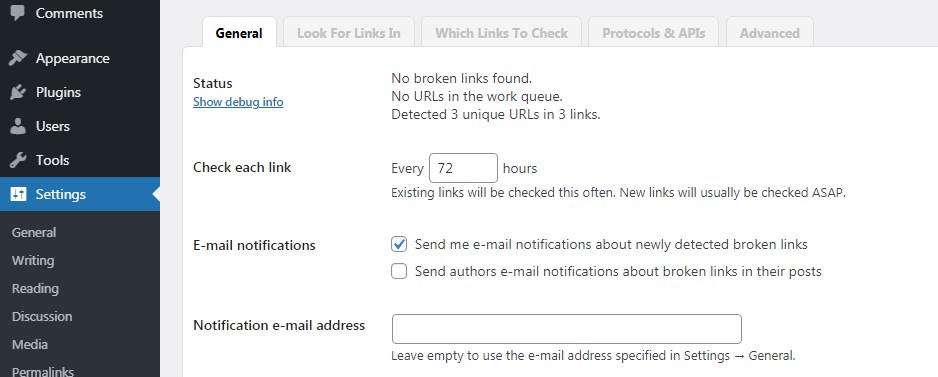
To begin, download and install the plugin from the WordPress repository. Once installed, the plugin will automatically check for broken links.
To find out if there are any, navigate to Dashboard > Settings > Link Checker, where you will be shown the status of broken links on your website.
9. Increase PHP Memory
By default, most hosting services offer around 32mb of PHP memory. This will usually be enough for any website to get started, but as yours grows, you may need a little more.
You can reach out to your web host asking them to increase your PHP allocation, or simply do it yourself.
There are many different methods to increase your PHP memory allocation. A simple fix is to navigate to Appearance > Editor > functions.php and enter this line of code:
define('WP_MEMORY_LIMIT','256M');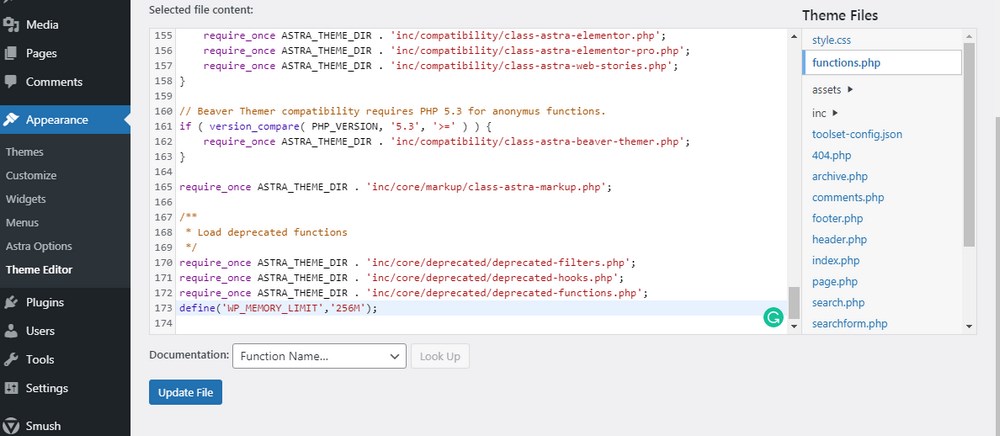
Save the file and you should be good to go.
WordPress Maintenance Tasks for SEO
Like the other important maintenance tasks on this list, SEO isn’t something that you do once and forget. Even the highest ranking piece of content today could very easily lose its top spot to better, more relevant content in the future.
To ensure that you stay on top of your SEO game, remember to constantly carry out maintenance in the following areas:
10. Content Audit
As we’ve noted, even the highest ranking piece of content may easily lose its top spot if a competitor is able to produce something better.
The best practice would be to stay one step ahead of everyone else by constantly improving your own content.
There are three major factors to pay attention to:
New knowledge in the field
Search engines appreciate updated content. This is particularly true when there have been new developments in a particular field. For example, with Google’s Page Experience algorithm rolling out in June, SEO guides that do not reference this will likely become outdated and will likely lose some positions in search rankings.
Outbound links
With time, outbound links may lose their relevance, may be replaced by entirely different content, or simply become unavailable. You should check to ensure that any outbound links in your content still link to the content you originally intended, and that this content is still relevant. To do this, you need to manually review each link in your content by clicking on it and following through to the destination.
Content gap analysis
Using a paid SEO tool like Ahrefs, you can find out more about how your content is performing compared to the competition. Ahrefs, in particular, has a content gap analysis tool that helps you see what keywords your competitors are ranking for in relation to a given keyword.
You can also use Google search console’s search performance data to discover keywords that your content performs well for. Once you know this, you will have a better idea of what to focus on.
11. Optimize Images
Image optimization is best done while uploading any images. Hopefully, you have already made this a consistent practice. Large image files will needlessly slow down your website.
If you run a large website with multiple authors, you may need to periodically check that everyone is keeping up with the same standards.
The best way to do this is by using an image optimization plugin such as Smush. With Smush, once the plugin has been downloaded and installed, all images will be automatically optimized.
12. Check for Negative SEO Attacks
Unfortunately, negative SEO is a real thing, and you have to keep an eye out for it. Negative SEO is a black hat SEO tactic where a webmaster might focus on sabotaging their competitor’s rankings.
This can be done in a number of ways such as by targeting your website with toxic backlinks.
If your website suddenly begins to perform very poorly in search results, a negative SEO attack will be an obvious threat to explore. At other times, it won’t be so obvious.
To proactively check for negative SEO attacks, you may use a tool such as ahrefs to analyze your website’s backlinks.
If you find any spammy backlinks, you can resolve these in one of two ways. First, you can contact the webmaster of the referring site and ask that the links to your website be removed.
If this is not forthcoming, a more serious and more permanent step would be to use Google Search Console’s disavow tool. This tool informs Google’s PageRank algorithm not to follow the links from these websites to yours.
13. Delete Spam Comments
Spam can be annoying to read but that’s not the only reason why you don’t want it on your website. If you permit loads of spam comments, it will likely affect your search rankings.
There is also the risk of reputational damage to your brand.
Fortunately, spam is easy to deal with. As a first line of defence, take advantage of discussion settings in WordPress.
Navigate to your Dashboard > Settings > Discussion > Other comment settings.

Once here, you may require that commenters provide their name and email address in order to make a comment. While this will not stop a determined spam commenter, it might serve to discourage or deter most.
Additionally, in the comment moderation section, you can also tell WordPress not to publish any comments with links in them.
You might also want to consider using the Akismet plugin to set up more elaborate anti-spam defences.
6 Best WordPress maintenance and support services
If you know WordPress well, performing essential maintenance will be quick and painless.
If you don’t know WordPress so well or don’t have much free time, you may prefer to hire a WordPress maintenance service.
A maintenance service can take care of all the back end tasks and leave you free to concentrate on running your website.
They can offer services such as proactive maintenance, malware protection, backups, plugin updates, security, WooCommerce store support, bug fixes and a range of ad-hoc support services should you need them.
Here are some other WordPress maintenance companies to consider:
WordPress services may charge per task, or may offer a retainer. Hiring someone is more expensive than doing it yourself. But, you might appreciate having someone to look after your website while you focus on other areas of your business.
SiteCare
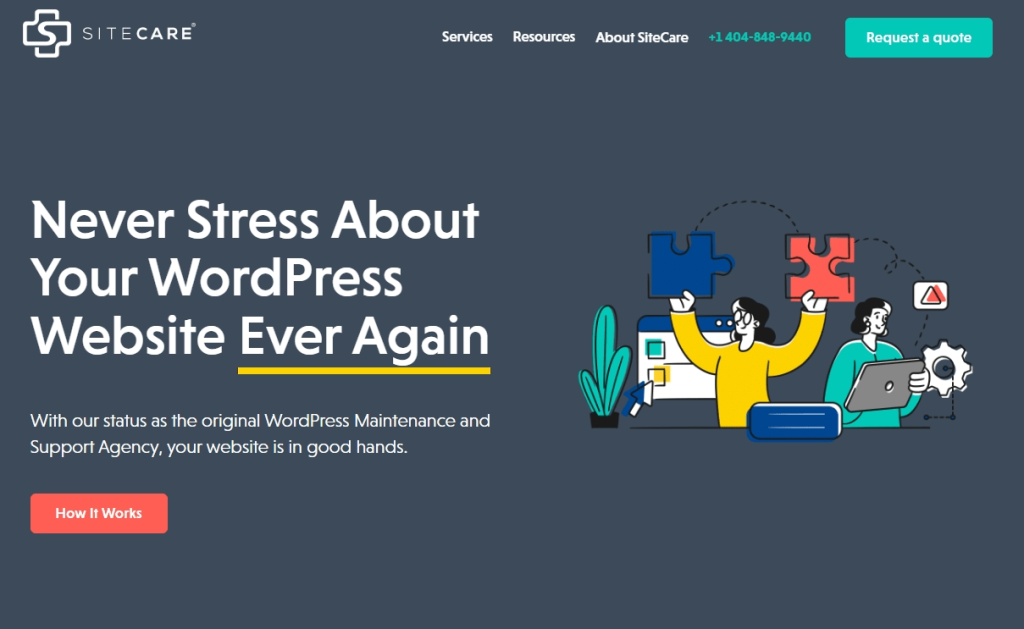
SiteCare is a US-based WordPress maintenance company that offers everything from speeding up WordPress to security.
Services include performance upgrades, bug fixing, development services, uptime monitoring, site restoration from backups, automated deployments and emergency assistance.
FixRunner
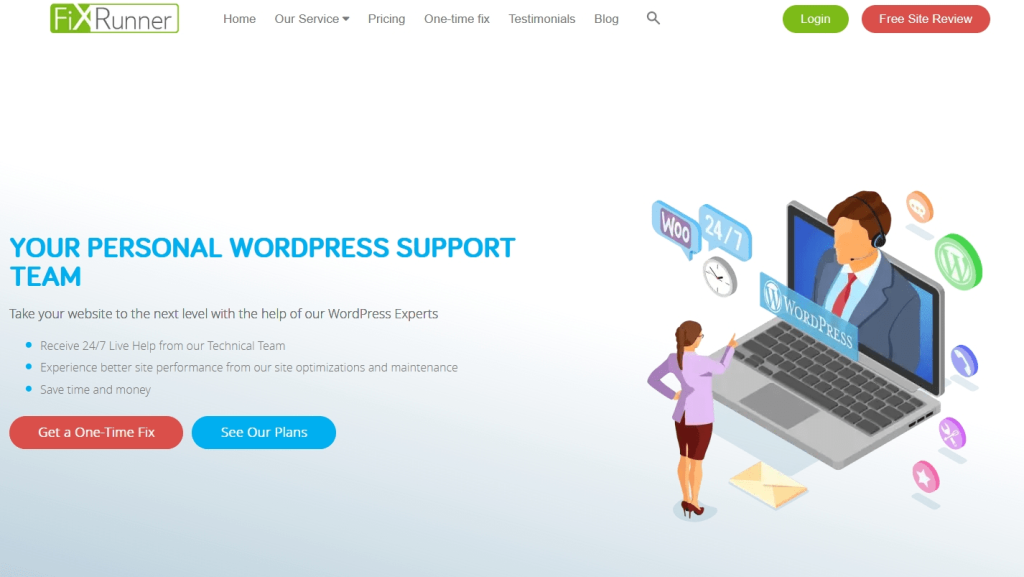
FixRunner is another US-based WordPress maintenance company. It offers full support for websites and eCommerce stores on a retainer and as a one-off.
Services include ticketed support for any WordPress issue, updates for WordPress and plugins, optimizations, cloud backups, uptime monitoring and 24/7 security monitoring.
WP Buffs
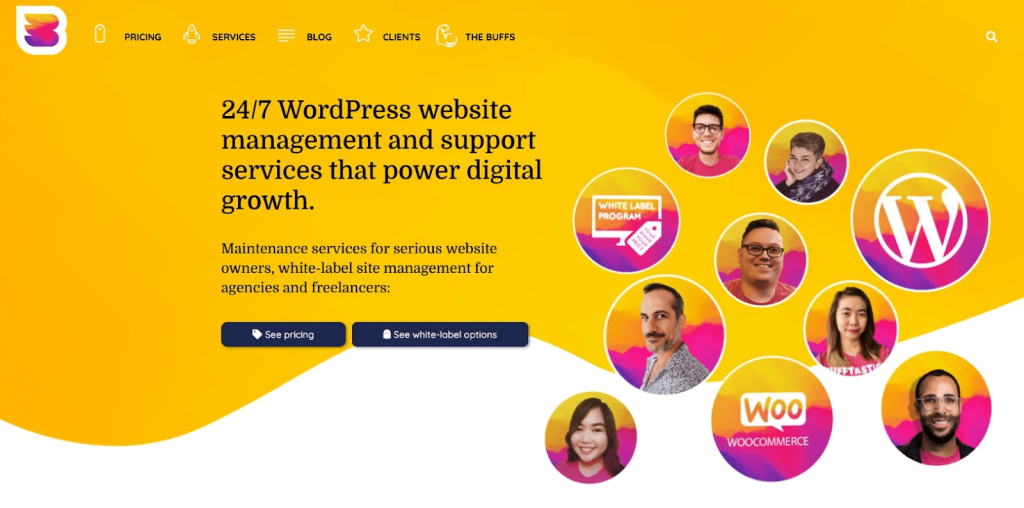
WP Buffs is based in Boston and provides personal and white label WordPress maintenance services paid monthly or annually.
Services include speed optimizations, managed security, site, theme and plugin updates, 24/7 emergency support, file and database backups, responsiveness auditing and malware removal.
GoWP
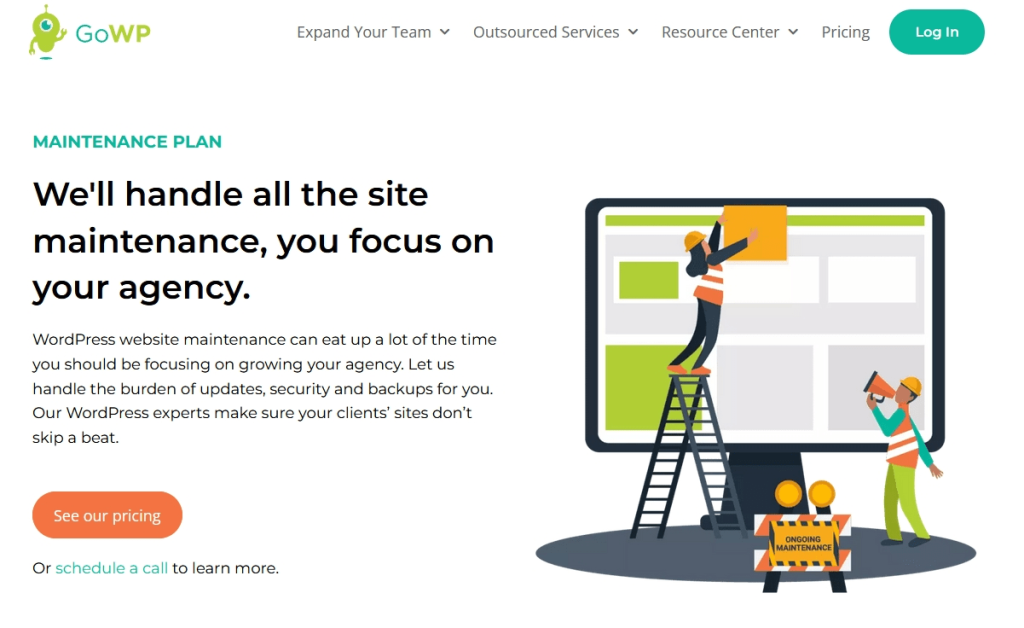
GoWP is based in Georgia, US and offers a range of WordPress maintenance services paid on a monthly basis.
Services include WordPress core and plugin updates, security monitoring, malware scans and recovery, backups and a range of content and development services. There’s also a lot of emphasis on white labeling and outsourcing, which may appeal to some.
Maintainn
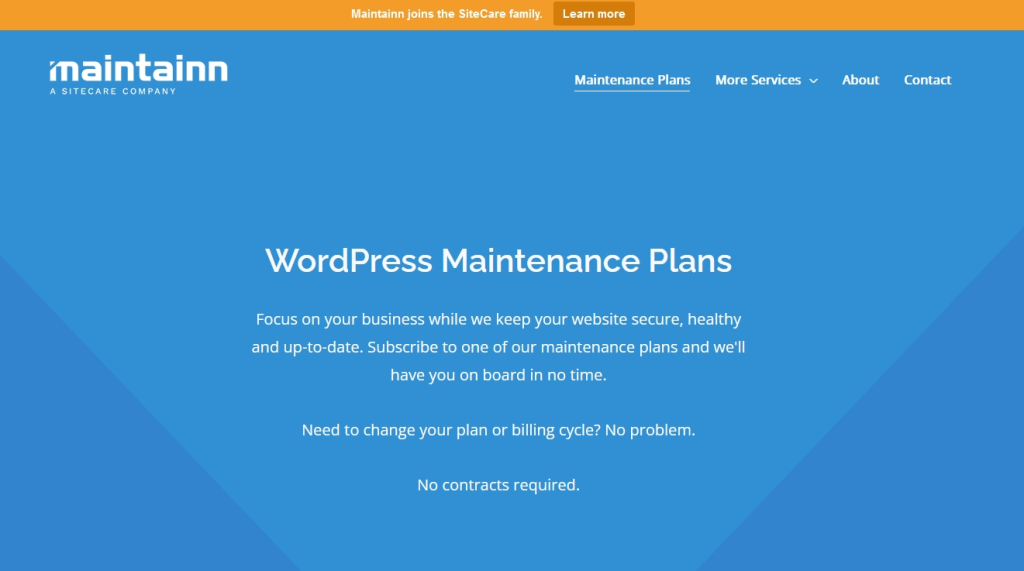
Maintainn was bought by SiteCare so is a US-based WordPress maintenance company that offers a range of plans paid monthly or annually.
Services include 24/7 security monitoring, offsite backups, core updates, theme and plugin updates. The company also offers development, bug fixing and troubleshooting as a separate service.
WP Maintainer
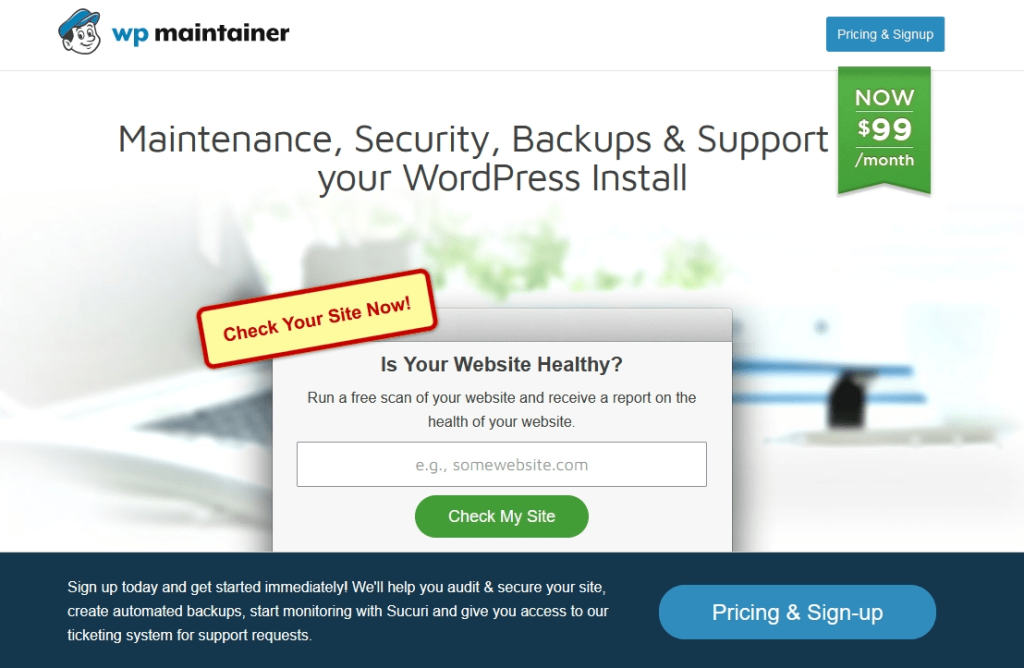
WP Maintainer doesn’t make it clear where they are from so due diligence will be needed if you want to use their service, for data protection purposes. Otherwise, it’s a monthly plan.
Services include WordPress core, plugin and theme updates, WordPress migration, malware monitoring (via Sucuri), backups and development support.
Get Started With Your WordPress Website Maintenance
If you’ve got a beautiful website that you love and are proud of, be sure to take good care of it!
Maintaining WordPress is important but it’s also relatively easy. Now you know what to do and how to do it, you can keep your website running efficiently and securely.
One of the most important things to keep with are updates to the WordPress core, plugins, and themes.
Also remember to begin your WordPress maintenance by creating regular backups of your files.
With regular backups, your website will always be one click away no matter what goes wrong.
The rest is easy!
What’s in your WordPress maintenance routine? Did we miss anything?If you have any other tips you would like to share, please let us know in the comments!
Disclosure: This blog may contain affiliate links. If you make a purchase through one of these links, we may receive a small commission. Read disclosure. Rest assured that we only recommend products that we have personally used and believe will add value to our readers. Thanks for your support!






Great resources! Very helpful. Thank you!
Hello Deanna, glad to hear that the article has helped.
Just went to install Broken Link Checker on my site colinjamesweb, unfortunately, it hasn’t been updated since WP 4.60, so a non-starter for me. However, came across miniOrange Broken Link Checker, updated in last 7 days, ran it and it found an embarrisngly large number of broken links – I know what I’ll be doing this weekend.
Glad to hear that you found it useful, do share it with your peers as well!
Hello, Buddy.
I think you left out Caremywp. Caremywp is the only support firm that allows support requests to expand the existing functionality of plugins or themes on a website.
Hello there, thank you for the suggestion.